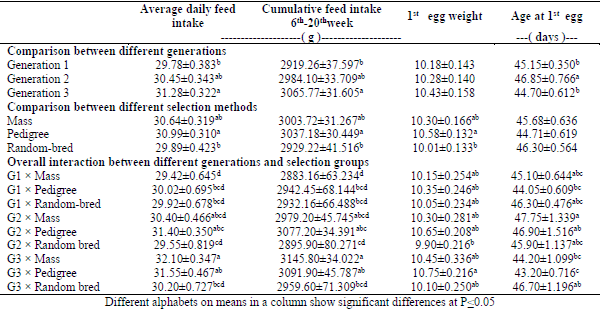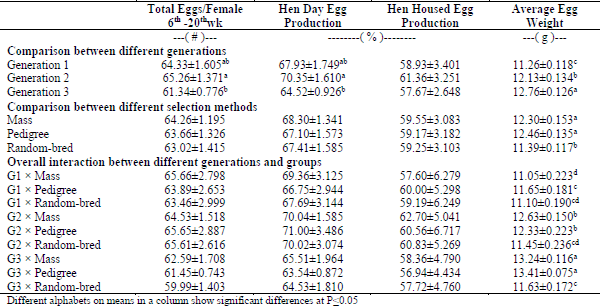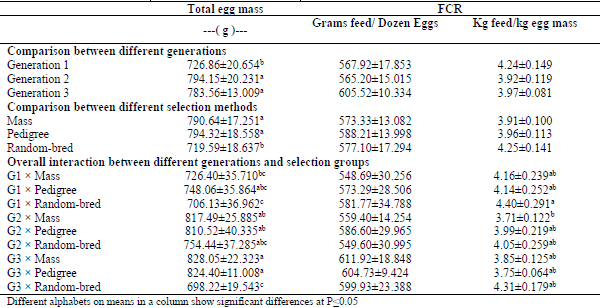Quail Breeder’s Production Performance in Response to Selection for Higher Three Weeks Body Weight
The present study was executed to compare breeder performance parameters (feed intake, Age at 1st egg, egg weight, hen day & hen house production %, FCR /kg and/dozen eggs) in mass selected (MS), pedigree based selected (PS) and random bred controls (RBC), in three consecutive generations of Japanese quail. In generation1 (G1), 11000 quail chicks were randomly distributed into 22 sub-groups. After 3 weeks, birds were weighed and sexed; the higher body weight birds were selected as the parents of next generation. Out of 22 groups, first group was maintained with fully pedigree record, in second group birds were picked randomly without following any selection procedure, rest 20 groups were subjected to mass selection. Pedigree selection significantly improved egg weight, egg mass and FCR/ kg egg mass in higher body weight selected birds with the advancement in generations. Hence, it can be concluded that short term selection for higher 3-week body weight in quails exhibited little or no deterioration, rather improved subsequent production performance with the advancement of generations.
Key words: Selection, Japanese quail, age at 1st egg, egg production performance, Egg mass, FCR/kg egg mass
μ = Overall Population mean
αi = First factor effect (Generations i= 3)
βj = Second factor effect (Selection methods j = 3)
(αβ)ij= interaction effect
εijk = Residual effect



Aboul-Hassan, M.A., F.A. El-Fiky, and G.E.Y. Attalah(1999). Selection for growth traits in Japanese quail. 2- Correlated response. Al- Azhar. J. Agr. Res. 29:55-70.
Aboul-Hassan, M.A. (2001a). Crossbreeding effects on some growth and egg production traits among two strains of Japanese quail. Al-Azhar. J. Agr. Res. 34:41-57.
Aboul-Hassan, M.A. (2001b). Selection for high egg production in Japanese quail: Direct and correlated responses. Al-Azhar. J. Agr. Res. 34:25-40.
Afanasiev, G.D. (1991). Breeds and versions in Japanese quails. Pticevodstvo. 3:12-15.
Akhtar, N., S. Mahmood, M. Hassan, and F. Yasmeen (2007). Comparative study of production potential and egg characteristics of Lyallpur Silver Black, Fayoumi and Rhode Island Red breeds of poultry. Pakistan Vet. J. 27(4):184- 188.
Altan, O., I. Oguz, and Y. Akbas (1998). Effects of selection for high body weight and age of hen on egg characteristics in Japanese quail (Coturnix coturnix japonica). Turk. J. Vet. Anim. Sci. 22: 467-473.
Altinel, A., H. Gunep, T. Kirmizibayrak, S.G. Corekci, and T. Bilal(1996). The studies on egg quality characteristics of Japanese quails. J. Fac. Vet. Univ. Istanbul. Turkey. 22(1):203-213.
Anthony, N.B., E.A. Dunnington, and P.B. Siegel(1989). Embryo growth of normal and dwarf chickens from lines selected for high and low 56-day body weight. Arch. Geflug. 53:116-122.
Anthony, N.B., K.E. Nestor, and H.L. Marks(1996). Short-term selection for four-week body weight in Japanese quail. Poult. Sci. 75(10):1192-1197.
Chahil, P.S., W.A. Johanson, and P.E. Schilling(1975). Combining ability in a di-allel cross of three lines of Coturnix coturnix japonica. Poult. Sci. 54:1844-1849.
Darden, J.R. and H.L. Marks(1988). Divergent selection for growth in Japanese quail under split and complete nutritional environments 1. Genetic correlated responses to selection. Poult. Sci. 7:519-529.
Duncan, D.B. (1955). Multiple range and multiple F tests. Biometrics. 11:1-42.
El-Fiky, F.A. (2005). Selection for high body weight at six weeks of age in Japanese quail. Direct and correlated responses. Al-Azhar. J. Agr. Res. 42:15-27.
Hanan, A.H. (2010). Variations in egg performance and plasma constituents at different ages of female Japanese quail. Egypt. Poult. Sci. 30(2):565-581.
Harms, R.H., T.P. Costa, and R.D. Miles(1982). Daily feed intake and performance of laying hens grouped according to body weight. Poult. Sci. 6(16):1021-1028.
Hassan, M.M., E. Haq, and F. Ahmad(2008). Effect of age and body weight at molting on the performance of broiler breeder hens under environmental control houses in Pakistan. Pakistan Vet. J. 28(4):189-193.
Hussain, J., M. Akram, A.W. Sahota, K. Javed, H.A. Ahmad, S. Mehmood, S. Ahmad, R. Sulaman, I. Rabbani (2013). Selection for higher three week body weight in Japanese quail. 1: Effect on growth performance. J. Anim. Plant. Sci. 23(6):1496-1500.
Ipek, A., and U. Sahan (2004). Effect of breeder age and breeding season on egg production and incubation in farmed Ostriches. Br. Poult. Sci. 45:643-647.
Kosba, M.A., M.B. El-Deen, and H.M. Shalan (2003). Long-term selection for body weight in Japanese quail under Egyptian conditions. 3- Correlated responses of egg production traits. Egypt. Poult. Sci. 23:961-975.
Krapu, G.L. (1981). The role of nutrient reserves in mallard reproduction. Auk. 98:29-38.
Lacin, E., A. Yildiz, N. Esenbuga, and M. Macit (2008). Effect of differences in the initial body weight of groups on laying performance and egg quality parameters of Lohmann laying hens. Czech. J. Anim. Sci. 53(11):466-471.
Leeson, S., L. Caston, and J.D. Summers (1997). Layer performance of four strains of Leghorn pullets subjected to various rearing programs. Poult. Sci. 76(1):1-5.
Michael, F., Festing, A.W. Nordskog(1967). Response to selection for body weight and egg weight in chickens. Genet. 55:219-231.
Nath, N.D., F.R. Sheriff, R. Prabakaran, and R. A. Rajini(2011). Response to Short Term Index Selection for Economic Traits in Meat Type Japanese quail. JIVA. 9(3).
Nazligul, A., K. Turkyilmaz, and H.E. Bardalciodlu(2001). A study on some production traits and egg quality characteristics of Japanese quail. Turk. J. Vet. Anim. Sci. 25:1007-1013.
North, M.O., and D. D. Bell(1990). Commercial Chicken Production Manual, 4th Ed. Van Nostrand Reinhold.
National Research Council. (1994). Nutrient Requirements of Poultry. 9th Ed. Natl. Acad. Press, Washington, DC.
Oluyemi, J. A., and F. A. Roberts(1979). Poultry Production in Warm wet climate. Mac Millan Press Ltd, London.
Reddish, J.M., K.E. Nestor, and M.S. Lilburn(1993). Effect of selection for growth on onset of sexual maturity in randombred and growth-selected lines of Japanese quail. Poult. Sci. 82:187-191.
Rehman, Z. U. (2006). Comparative productive performance of Japanese quail from different local and imported stocks. M.Phil Thesis (Unpublished). Deptt. of Poult. Prod., Fac.Anim. Prod. Tech., Univ. Vet. Anim. Sci., Lahore, Pakistan.
SAS Institute. (2004). SAS® User's Guide: Statistics. SAS Institute Inc., Cary, NC.
Shoukat, A., M.S. Chaudhry, M.A. Bhatti, A. Ahmed, and M.S. Zaman (1988). Studies on the effect of egg weight on the weight gain, feed consumption, feed efficiency and mortality in Japanese quails. Pak. J. Sci. 39:157-160.
Steel, R.G.D., J.H. Torrie, and D.A. Dickey (1997). Principles and Procedures of Statistics. 3rd Ed., McGraw-Hill, Book Publishing Company, Toronto, Canada.









.jpg&w=3840&q=75)